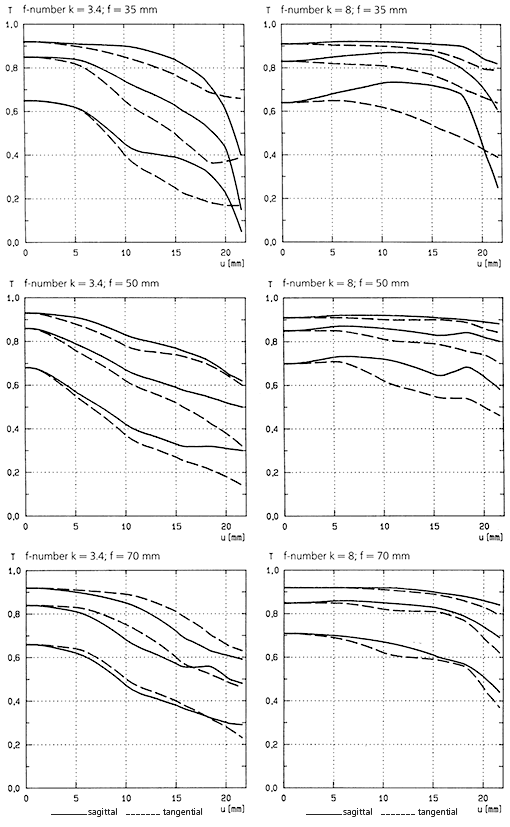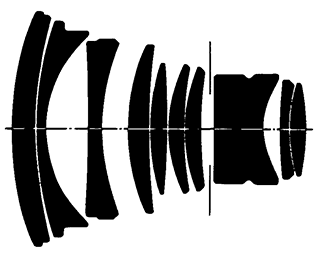

Carl Zeiss Vario-Sonnar T* 3.4/35-70 C/Y
My usage
...
Image quality
...
Sharpness and Contrast
Based on photos I have taken I have no reason to doubt that the measured MTF charts would
not be as Zeiss has them measured. Specially around 50mm the performance is surpricing me
every time when doing "pixel peeping" at 100% crops. Micro-contrast is very high at any focal
length af f/5.6 or smaller. Also it seems that lens takes small apertures pretty well. With
Canon EOS 5D mkII f/11 is fully usable and f/16 is usable but some contrast is lost.

According to Zeiss (underline parts different than in Canon's MTFs): "The Modulation
Transfer (MTF) as a function of image height (u) and slit orientation (sagittal, tangential)
has been measured with white light at spatial frequencies of R = 10, 20 and 40
cycles/mm."
Bokeh
Wide open - subjective
Closed down - subjective
highlight shapes - in corners "cateye" or not
highlight shapes - is the highlight circle having strong edges or soft edges
Lens flare
Backlight
Nightphotos on city => strong lights
Vignetting and distortion
...
Microcontrast
Textures etc.
Handling and usage
Focusing from infinity to 1 meter is about XXX degrees rotation.
XXX subjective description of manual focus resistance XXX.
XXX Manual focusing is very accurate and it's very easy to achieve accurate focus with live view.
Aperture can be selected 1 stop intervals. When using viewfinder and manually stopping
down it's easy to calculate "clicks" from wide open to determinen the aperture into
which lens is stopped down.
XXX subjective feeling of aperture adjustment if any XXX
XXX subjective description of focus ring width and usage with gloves if relevant XXX
XXX subjective description of lens hood if applicable - physical and flare protection XXX
XXX subjective description of lens cap when lens hood is used XXX
XXX Polarized usage with hood if applicable XXX
XXX Lens hood effectiveness with filters XXX
Build quality and basics
Build quality is as good as I could imagine, from different planet than Canon lenses.
 Lens dimensions with C/Y to EOS adapter and lens caps are:
diameter 70mm, length 80.5mm, weight 475+XXXg.
This lens isn't internal focusing and therefore extends when focused closer. Lens extends
about XXXmm when focused to minimum focus distance 0.7m. There is additional macro mode, which
can be used in wide end of the focal range.
Lens dimensions with C/Y to EOS adapter and lens caps are:
diameter 70mm, length 80.5mm, weight 475+XXXg.
This lens isn't internal focusing and therefore extends when focused closer. Lens extends
about XXXmm when focused to minimum focus distance 0.7m. There is additional macro mode, which
can be used in wide end of the focal range.
Lens uses filter size of 67mm, which is same as in Carl Zeiss Makro-Planar T* 2/100 ZF.
filter thread revolves when lens is focused and therefore lens has to be first focused
and then polarizer/ND-grad filter adjusted.
Minimum aperture is f/22. Largest aperture is f/3.4 and there is step for f/4 even it's not
marked to the lens barrel. Aperture has 8 blades and aperture remains pretty round at f/5.6
but after that it's clearly octaconal.
Lens has 10 elements which are in 10 groups. Actual focal length range is 35.7-69.0mm.
Minimum focus distance is 0.7m, which results 0.05-0.10x maximum magnification and full
frame (36mm x 24mm) coverage is between 706mm x 471mm and
365mm x 243mm. Magnification is calculated based on focal length and minimum
focus distance.
Macro mode
When lens focal length is set to 35mm lens can be set to macro mode. This is done by
turning focus ring to clockwise to macro range, which is marked with red color. In the
macro mode maximum magnification is 0.##x
Summary
Pros
+ excellent sharpness, contrast and microcontrast over all focal lengths and apertures
+ excellent colors
+ excellent flare resistance
+ macro mode
Cons
- when lens is focused filter thread rotates
-
-
-
See photos
in my picturebank taken with this lens.
Van Walree Photography - Optics (many good articles)
Canon TS-E lensesTilt and shift lenses (regarding all TS-E lenses)
TS-E 45/2.8 on the-digital-picrure.com
TS-E 24/3.5 on the-digital-picrure.com
TS-E 90/2.8 on the-digital-picrure.com
Sports with TS-E lenses by Vincent Laforet for the NY Times
Fred Miranda - how to correct CA when shift used
Cambridge in colour - Shift
Cambridge in colour - Tilt
Carl Zeiss lensesdigLloyd Zeiss ZF lenses
Zeiss.com - Carl Zeiss Distagon T* 35mm f/2.0
Zeiss.com - Carl Zeiss Makro-Planar T* 100mm f/2.0
16-9.net - Test of 28mm lenses including CZ 28/2.8
Pebble Place - Carl Zeiss Planar T* 2/100
Pebble Place - Carl Zeiss Macro-Sonnar T* 2.8/100 N
SLR Lens Review - Contax Sonnar T* 2.8/135mm C/Y
SLR Lens Review - Contax Sonnar T* 2.8/85mm C/Y
SLR Lens Review - Contax Planar T* 1.7/50mm C/Y
Pebble Place - Contax Sonnar T* 2.8/135mm C/Y
Some example pictures of Zeiss lenses
pinciuc.com - samples from various lenses
Nikon PC-Nikkor lenses16-9.net - Test of 35mm shift lenses
mir.com.my - PC-Nikkor 28mm f/3.5
mir.com.my - PC-Nikkor 35mm f/2.8
AdaptersPebble Place - C/Y adapters
Cambridge in colour - Understanding camera lenses
Photo.net - Lens tutorial
Pictures of Carl Zeiss Vario-Sonnar T* 3.4/35-70 C/Y
Lens extends when focused

Distance from EOS lens mount (including adapter) to end of the hood is XXXmm at infinity
and XXXmm at minimum focusing distance, and XXXmmm when in macro mode.
Front/side projection

Made in Germany.
|



 Lens dimensions with C/Y to EOS adapter and lens caps are:
diameter 70mm, length 80.5mm, weight 475+XXXg.
This lens isn't internal focusing and therefore extends when focused closer. Lens extends
about XXXmm when focused to minimum focus distance 0.7m. There is additional macro mode, which
can be used in wide end of the focal range.
Lens dimensions with C/Y to EOS adapter and lens caps are:
diameter 70mm, length 80.5mm, weight 475+XXXg.
This lens isn't internal focusing and therefore extends when focused closer. Lens extends
about XXXmm when focused to minimum focus distance 0.7m. There is additional macro mode, which
can be used in wide end of the focal range.
